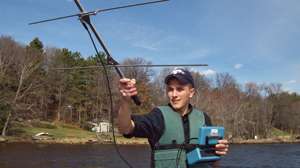
AUGUSTA, Wis. — Tim Kubetz has some revealing information to share with smallmouth bass anglers, following a radio telemetry study he conducted as his senior research project at Wildlands Science Research Center Charter School.
“One of the biggest eye-openers for me in this study had to do with fish location,” said the recent graduate, whose work was sponsored by the Wisconsin B.A.S.S. Federation Nation. “As fishermen, we tend to think that we have a pretty good idea of where fish should be in a given body of water.
“After finding these good spots, we tend to revisit them. The danger of this, as I learned in my study, is that we miss the rest of the lake.”
Kubetz added that he never found his tagged fish in his own “hot spots” on Lake Altoona, an 840-acre reservoir. “Instead, the fish were using areas that I never even thought to fish before. This study really revealed to me the importance of keeping an open mind while fishing.”
The young angler/researcher started with five tagged smallmouth, hoping to follow them from fall until transmitters lost battery life in the spring. Unfortunately, two transmitters failed prematurely and a third bass shed its tag. But he tracked the other two intensely until just before the spawn.
Both bass were most active during the fall, with Kubetz noting a shallow-water migration “that seemed to be directly related to baitfish location.
“One of my fish made frequent forays up onto the shallow, eastern flats that are known for concentrating schools of perch in late fall,” he explained. “The presence of the baitfish seemed to have such a strong attraction on my fish that it remained in water between 18 inches and 1 foot deep even when water temperature hit 42 degrees.”
During winter, the fish moved into channels and roamed little. Kubetz had theorized that the bass would migrate toward the dam, where the best-looking structure was located in 25 feet of water.
“Instead they chose to remain in their respective sections of the lake and winter in the deepest water that those areas had to offer. In fact, neither fish traveled more than 330 meters enroute from its fall to winter-holding areas. And even though the channel running through the eastern portion of the lake was only 9 feet deep, fish #333 remained there all winter because it was deep compared to the rest of the area.”
Spring surveillance was short-lived because of limited life of the tags, but the student did note that the fish “were very quick to relocate from their winters homes once the ice left the lake.” And after moving to these prespawn staging areas, they stayed, until water temperatures of 58 to 60 degrees prompted them to go shallow.
Kubetz concluded that “although the results of this study may not apply to all lakes, I feel confident that the general patterns and movements observed in this study are applicable to the smallmouth populations in many other similar bodies of water.”





